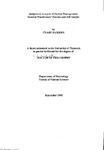Judgement Analysis of Patient Management: General Practitioners' Policies and Self-Insight.
| dc.contributor.author | HARRIES, CLARE | |
| dc.contributor.other | School of Psychology | en_US |
| dc.date.accessioned | 2013-09-10T10:58:57Z | |
| dc.date.available | 2013-09-10T10:58:57Z | |
| dc.date.issued | 1995 | |
| dc.identifier | NOT AVAILABLE | en_US |
| dc.identifier.uri | http://hdl.handle.net/10026.1/1630 | |
| dc.description.abstract |
In this thesis judgement analysis (multiple linear regression techniques) was used to look at both GPs' decisions to prescribe certain types of drug for patients and their judgements of patients' risk of coronary heart disease. All of these were idiographic analyses in that decision making by each GP was modelled separately. Judgement analysis (paramorphically) describes a subject's judgement or decision making policy in terms of the relative influence of different pieces of information. The amount of information subjects could take into account was limited. For all types of judgement or decision doctors were influenced on average by only four of the thirteen or twelve cues available. The decision to prescribe one of the types of drug was modelled not only in terms of the individual effects of cues (judgement analysis) but also in terms of the influence of the doctor's assessment of the patient's risk. Doctors agreed more about judgements of risk and the factors influencing this than about prescription. Doctors only prescribed to patients they rated as at high risk but factors such as for example smoking behaviour led some doctors not to prescribe to individuals in this group. Judgement and decision making policies (explicit policies) were also elicited verbally from doctors. These showed greater agreement than the policies captured using judgement analysis (tacit policies) did. When these explicit policies were compared to tacit policies a moderate amount of correspondence was found. However, doctors tended to over-rate the importance of certain cues. A number of explanations for this pattern of self-insight were investigated including the possibilities that doctors have self-insight but are unable to state it and that the pattern was an artefact of linear modelling. Both of these hypotheses were rejected. Subjects' explicit policies were found to resemble the pattern of selection of information more than the pattern of its use. Both the hypotheses that subjects' explicit policies were based on phenomenal knowledge and that they are based on some ideal model (influencing which cues are selected) were supported. | en_US |
| dc.language.iso | en | en_US |
| dc.publisher | University of Plymouth | en_US |
| dc.title | Judgement Analysis of Patient Management: General Practitioners' Policies and Self-Insight. | en_US |
| dc.type | Thesis | |
| plymouth.version | Full version | en_US |
| dc.identifier.doi | http://dx.doi.org/10.24382/4453 | |
| dc.identifier.doi | http://dx.doi.org/10.24382/4453 |
Files in this item
This item appears in the following Collection(s)
-
01 Research Theses Main Collection
Research Theses Main


